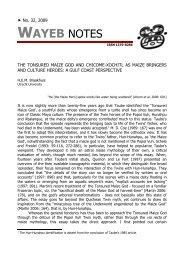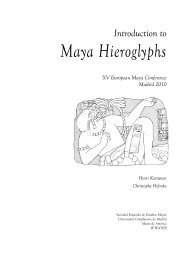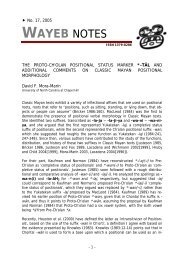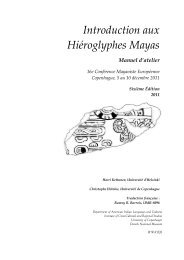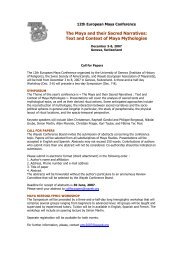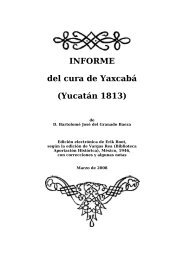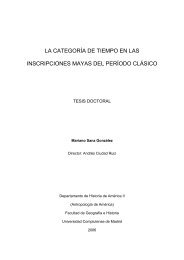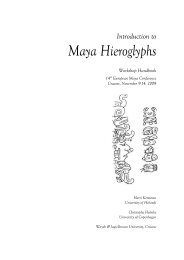Introduction to Maya Hieroglyphs - Wayeb
Introduction to Maya Hieroglyphs - Wayeb
Introduction to Maya Hieroglyphs - Wayeb
You also want an ePaper? Increase the reach of your titles
YUMPU automatically turns print PDFs into web optimized ePapers that Google loves.
Kettunen & Helmke 2011<br />
Glossary of Linguistic Terminology<br />
ideographic<br />
An ideographic orthography is a writing system that represents words and ideas without representing the sounds<br />
of a given language. In reality, there are no true ideographic writing systems in the world, and most writing<br />
systems employing prima facie ideographs are actually operating with logograms (i.e. word signs that do not<br />
always have a direct correlation or association with the targeted idea or entity in real life). Words “ideogram” (or<br />
“ideograph”) and “logogram” (or “logograph”) are sometimes used indistinguishably but currently the latter is<br />
favored in place of the former. A “pic<strong>to</strong>gram” (or “pic<strong>to</strong>graph”), on the other hand, is a sign representing factual<br />
and concrete objects or entities: a sign representing a realistic full-figure jaguar (or the head of the jaguar) would<br />
be pic<strong>to</strong>graphic (if it really denotes <strong>to</strong> a jaguar), but a sign representing a head of a <strong>to</strong>ad is in effect a logogram if it<br />
denotes <strong>to</strong> the verb ‘<strong>to</strong> be born’.<br />
idiom<br />
An idiosyncratic multi-word expression with a fixed combination of elements recognized as a SEMANTIC unit and<br />
typically referring <strong>to</strong> a colloquial expression (for example “kick the bucket”, “spill the beans”, “hit the road”). The<br />
meaning of the idiom cannot usually be directly derived from its elements. See also EUPHEMISM.<br />
inalienable noun<br />
A noun which refers <strong>to</strong> something perceived as essentially and permanently possessed, and is thus compulsorily<br />
expressed as possessed. Kinship terms and body parts are traditionally inalienable nouns in <strong>Maya</strong> languages.<br />
inchoative<br />
An aspectual class of verbs that refers <strong>to</strong> “becoming”, “appearing” or “beginning”. Inchoatives express the<br />
beginning of a state or process, like harden (become hard), die (become dead) or break. They refer <strong>to</strong> a change in<br />
state in the subject, be it accidental, temporary, or permanent. In <strong>Maya</strong> languages all inchoative verbs are derived<br />
from NOUNS or ADJECTIVES.<br />
inflection<br />
One of the major types of MORPHOLOGICAL operations by which an AFFIX is added <strong>to</strong> a word. An inflectional affix<br />
adds a particular grammatical function <strong>to</strong> a word without changing the category of that word. Traditionally<br />
inflection is distinguished from DERIVATION.<br />
intransitive<br />
Intransitive verbal structures do not have a direct OBJECT, i.e. verbs that do not require or verbs that cannot have a<br />
direct object, are intransitive verbs (e.g. “sleep” and “die”).<br />
labial<br />
A sound which is produced by a narrowing or closure of the lips. The term is used <strong>to</strong> refer both <strong>to</strong> BILABIAL and <strong>to</strong><br />
labiodental sounds. There are five (bi)labial sounds in the Classic <strong>Maya</strong>: [p], [p’], [b], [m], and [w], and no<br />
labiodental sounds (involving a contact between the lower lip and upper front teeth, such as [f] and [v]).<br />
lexeme<br />
A term that is used <strong>to</strong> express the idea that INFLECTED forms of words (which are words themselves) are still<br />
variants of one single word. For example, the Finnish words “käden” (“hand’s”, “[that] of a hand”), “kädellinen”<br />
(“one with a hand”, “Primates”), “käsitellä” (“manipulate”), and “käsin” (“with hands”) are all “variants” of the<br />
lexeme “käsi” or “hand”.<br />
136/154



